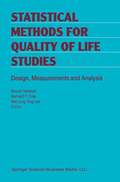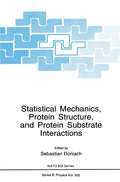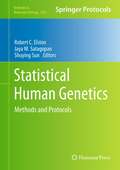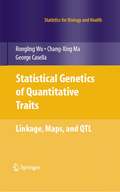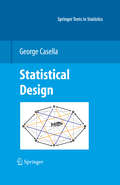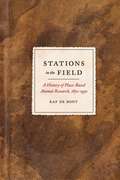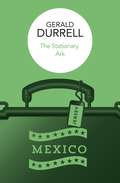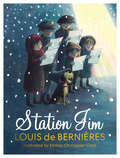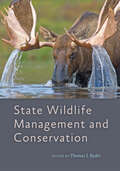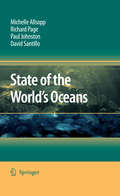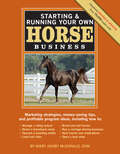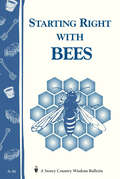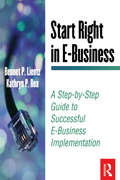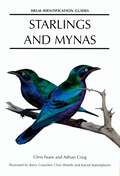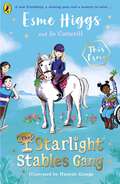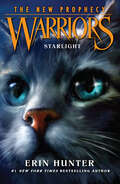- Table View
- List View
Statistical Thermodynamics for Chemists and Biochemists
by Arieh Y. Ben-NaimThis book was planned and written with one central goal in mind: to demonstrate that statistical thermodynamics can be used successfully by a broad group of scientists, ranging from chemists through biochemists to biologists, who are not and do not intend to become specialists in statistical thermodynamics. The book is addressed mainly to gradu ate students and research scientists interested in designing experiments the results of which may be interpreted at the molecular level, or in interpreting such experimental results. It is not addressed to those who intend to practice statistical thermodynamics per se. With this goal in mind, I have expended a great deal of effort to make the book clear, readable, and, I hope, enjoyable. This does not necessarily mean that the book as a whole is easy to read. The first four chapters are very detailed. The last four become progressively more difficult to read, for several reasons. First, presuming that the reader has already acquired familiarity with the methods and arguments presented in the first part, I felt that similar arguments could be skipped later on, leaving the details to be filled in by the reader. Second, the systems themselves become progressively more com plicated as we proceed toward the last chapter.
Statistical Methods for Quality of Life Studies: Design, Measurements and Analysis
by Mounir Mesbah Bernard F. Cole Mei-Ling Ting Mei-Ling Ting LeeOn October 16 and 17, 2000, we hosted an international workshop entitled "Statistical Design, Measurement, and Analysis of Health Related Quality of Life." The workshop was held in the beautiful city of Arradon, South Brittany, France with the main goal of fostering an interdisciplinary forum for discussion of theoretical and applied statistical issues arising in studies of health-related quality of life (HRQoL). Included were biostatisticians, psychometricians and public health professionals (e.g., physicians, sociologists, psychologists) active in the study ofHRQoL. In assembling this volume, we invited each conference participant to contribute a paper based on his or her presentation and the ensuing and very interesting discussions that took place in Arradon. All papers were peer-reviewed, by anonymous reviewers, and revised before final editing and acceptance. Although this process was quite time consuming, we believe that it greatly improved the volume as a whole, making this book a valuable contribution to the field ofHRQoL research. The volume presents a broad spectrum of papers presented at the Workshop, and thus illustrates the range of current research related to the theory, methods and applications of HRQoL, as well as the interdisciplinary nature ofthis work. Following an introduction written by Sir David Cox, it includes 27 articles organized into the following chapters.
Statistical Mechanics, Protein Structure, and Protein Substrate Interactions (Nato Science Series B: #325)
by Sebastian DoniachA number of factors have come together in the last couple of decades to define the emerging interdisciplinary field of structural molecular biology. First, there has been the considerable growth in our ability to obtain atomic-resolution structural data for biological molecules in general, and proteins in particular. This is a result of advances in technique, both in x-ray crystallography, driven by the development of electronic detectors and of synchrotron radiation x-ray sources, and by the development ofNMR techniques which allow for inference of a three-dimensional structure of a protein in solution. Second, there has been the enormous development of techniques in DNA engineering which makes it possible to isolate and clone specific molecules of interest in sufficient quantities to enable structural measurements. In addition, the ability to mutate a given amino acid sequence at will has led to a new branch of biochemistry in which quantitative measurements can be made assessing the influence of a given amino acid on the function of a biological molecule. A third factor, resulting from the exponential increase in computing power available to researchers, has been the emergence of a growing body of people who can take the structural data and use it to build atomic-scale models of biomolecules in order to try and simulate their motions in an aqueous environment, thus helping to provide answers to one of the most basic questions of molecular biology: the relation of structure to function.
Statistical Human Genetics: Methods and Protocols (Methods in Molecular Biology #850)
by Robert C. Elston, Jaya M. Satagopan and Shuying SunRecent advances in genetics over the last quarter of a century, especially in molecular techniques, have dramatically reduced the cost of determining genetic markers and hence opened up a field of research that is increasingly helping to detect, prevent and/or cure many diseases that afflict humans. In Statistical Human Genetics: Methods and Protocols expert researchers in the field describe statistical methods and computer programs in the detail necessary to make them more easily accessible to the beginner analyzing data. Written in the highly successful Methods in Molecular Biology™ series format, with examples of running the programs and interpreting the program outputs, the chapters include the kind of detailed description and implementation advice that is crucial for getting optimal results from human genetic data collected in the laboratory. Thorough and as much as possible intuitive, Statistical Human Genetics: Methods and Protocols aids scientists in understanding the computer programs and analytical procedures they need to use.
Statistical Genetics of Quantitative Traits: Linkage, Maps and QTL (Statistics for Biology and Health)
by Rongling Wu Changxing Ma George CasellaThis book introduces the basic concepts and methods that are useful in the statistical analysis and modeling of the DNA-based marker and phenotypic data that arise in agriculture, forestry, experimental biology, and other fields. It concentrates on the linkage analysis of markers, map construction and quantitative trait locus (QTL) mapping, and assumes a background in regression analysis and maximum likelihood approaches. The strength of this book lies in the construction of general models and algorithms for linkage analysis, as well as in QTL mapping in any kind of crossed pedigrees initiated with inbred lines of crops.
Statistical Design (Springer Texts in Statistics)
by George CasellaStatistical design is one of the fundamentals of our subject, being at the core of the growth of statistics during the previous century. In this book the basic theoretical underpinnings are covered. It describes the principles that drive good designs and good statistics. Design played a key role in agricultural statistics and set down principles of good practice, principles that still apply today. Statistical design is all about understanding where the variance comes from, and making sure that is where the replication is. Indeed, it is probably correct to say that these principles are even more important today.
Stations in the Field: A History of Place-Based Animal Research, 1870-1930
by Raf De BontWhen we think of sites of animal research that symbolize modernity, the first places that come to mind are grand research institutes in cities and near universities that house the latest in equipment and technologies, not the surroundings of the bird’s nest, the octopus’s garden in the sea, or the parts of inland lakes in which freshwater plankton reside. Yet during the late nineteenth and early twentieth centuries, a group of zoologists began establishing novel, indeed modern ways of studying nature, propagating what present-day ecologists describe as place-based research. Raf De Bont’s Stations in the Field focuses on the early history of biological field stations and the role these played in the rise of zoological place-based research. Beginning in the 1870s, a growing number of biological field stations were founded—first in Europe and later elsewhere around the world—and thousands of zoologists received their training and performed their research at these sites. Through case studies, De Bont examines the material and social context in which field stations arose, the actual research that was produced in these places, the scientific claims that were developed there, and the rhetorical strategies that were deployed to convince others that these claims made sense. From the life of parasitic invertebrates in northern France and freshwater plankton in Schleswig-Holstein, to migratory birds in East Prussia and pest insects in Belgium, De Bont’s book is fascinating tour through the history of studying nature in nature.
Stations in the Field: A History of Place-Based Animal Research, 1870-1930
by Raf De BontWhen we think of sites of animal research that symbolize modernity, the first places that come to mind are grand research institutes in cities and near universities that house the latest in equipment and technologies, not the surroundings of the bird’s nest, the octopus’s garden in the sea, or the parts of inland lakes in which freshwater plankton reside. Yet during the late nineteenth and early twentieth centuries, a group of zoologists began establishing novel, indeed modern ways of studying nature, propagating what present-day ecologists describe as place-based research. Raf De Bont’s Stations in the Field focuses on the early history of biological field stations and the role these played in the rise of zoological place-based research. Beginning in the 1870s, a growing number of biological field stations were founded—first in Europe and later elsewhere around the world—and thousands of zoologists received their training and performed their research at these sites. Through case studies, De Bont examines the material and social context in which field stations arose, the actual research that was produced in these places, the scientific claims that were developed there, and the rhetorical strategies that were deployed to convince others that these claims made sense. From the life of parasitic invertebrates in northern France and freshwater plankton in Schleswig-Holstein, to migratory birds in East Prussia and pest insects in Belgium, De Bont’s book is fascinating tour through the history of studying nature in nature.
Stations in the Field: A History of Place-Based Animal Research, 1870-1930
by Raf De BontWhen we think of sites of animal research that symbolize modernity, the first places that come to mind are grand research institutes in cities and near universities that house the latest in equipment and technologies, not the surroundings of the bird’s nest, the octopus’s garden in the sea, or the parts of inland lakes in which freshwater plankton reside. Yet during the late nineteenth and early twentieth centuries, a group of zoologists began establishing novel, indeed modern ways of studying nature, propagating what present-day ecologists describe as place-based research. Raf De Bont’s Stations in the Field focuses on the early history of biological field stations and the role these played in the rise of zoological place-based research. Beginning in the 1870s, a growing number of biological field stations were founded—first in Europe and later elsewhere around the world—and thousands of zoologists received their training and performed their research at these sites. Through case studies, De Bont examines the material and social context in which field stations arose, the actual research that was produced in these places, the scientific claims that were developed there, and the rhetorical strategies that were deployed to convince others that these claims made sense. From the life of parasitic invertebrates in northern France and freshwater plankton in Schleswig-Holstein, to migratory birds in East Prussia and pest insects in Belgium, De Bont’s book is fascinating tour through the history of studying nature in nature.
Stations in the Field: A History of Place-Based Animal Research, 1870-1930
by Raf De BontWhen we think of sites of animal research that symbolize modernity, the first places that come to mind are grand research institutes in cities and near universities that house the latest in equipment and technologies, not the surroundings of the bird’s nest, the octopus’s garden in the sea, or the parts of inland lakes in which freshwater plankton reside. Yet during the late nineteenth and early twentieth centuries, a group of zoologists began establishing novel, indeed modern ways of studying nature, propagating what present-day ecologists describe as place-based research. Raf De Bont’s Stations in the Field focuses on the early history of biological field stations and the role these played in the rise of zoological place-based research. Beginning in the 1870s, a growing number of biological field stations were founded—first in Europe and later elsewhere around the world—and thousands of zoologists received their training and performed their research at these sites. Through case studies, De Bont examines the material and social context in which field stations arose, the actual research that was produced in these places, the scientific claims that were developed there, and the rhetorical strategies that were deployed to convince others that these claims made sense. From the life of parasitic invertebrates in northern France and freshwater plankton in Schleswig-Holstein, to migratory birds in East Prussia and pest insects in Belgium, De Bont’s book is fascinating tour through the history of studying nature in nature.
Stations in the Field: A History of Place-Based Animal Research, 1870-1930
by Raf De BontWhen we think of sites of animal research that symbolize modernity, the first places that come to mind are grand research institutes in cities and near universities that house the latest in equipment and technologies, not the surroundings of the bird’s nest, the octopus’s garden in the sea, or the parts of inland lakes in which freshwater plankton reside. Yet during the late nineteenth and early twentieth centuries, a group of zoologists began establishing novel, indeed modern ways of studying nature, propagating what present-day ecologists describe as place-based research. Raf De Bont’s Stations in the Field focuses on the early history of biological field stations and the role these played in the rise of zoological place-based research. Beginning in the 1870s, a growing number of biological field stations were founded—first in Europe and later elsewhere around the world—and thousands of zoologists received their training and performed their research at these sites. Through case studies, De Bont examines the material and social context in which field stations arose, the actual research that was produced in these places, the scientific claims that were developed there, and the rhetorical strategies that were deployed to convince others that these claims made sense. From the life of parasitic invertebrates in northern France and freshwater plankton in Schleswig-Holstein, to migratory birds in East Prussia and pest insects in Belgium, De Bont’s book is fascinating tour through the history of studying nature in nature.
Stations in the Field: A History of Place-Based Animal Research, 1870-1930
by Raf De BontWhen we think of sites of animal research that symbolize modernity, the first places that come to mind are grand research institutes in cities and near universities that house the latest in equipment and technologies, not the surroundings of the bird’s nest, the octopus’s garden in the sea, or the parts of inland lakes in which freshwater plankton reside. Yet during the late nineteenth and early twentieth centuries, a group of zoologists began establishing novel, indeed modern ways of studying nature, propagating what present-day ecologists describe as place-based research. Raf De Bont’s Stations in the Field focuses on the early history of biological field stations and the role these played in the rise of zoological place-based research. Beginning in the 1870s, a growing number of biological field stations were founded—first in Europe and later elsewhere around the world—and thousands of zoologists received their training and performed their research at these sites. Through case studies, De Bont examines the material and social context in which field stations arose, the actual research that was produced in these places, the scientific claims that were developed there, and the rhetorical strategies that were deployed to convince others that these claims made sense. From the life of parasitic invertebrates in northern France and freshwater plankton in Schleswig-Holstein, to migratory birds in East Prussia and pest insects in Belgium, De Bont’s book is fascinating tour through the history of studying nature in nature.
The Stationary Ark (El\libro De Bolsillo Ser.)
by Gerald Durrell‘What we tried to do in Jersey is create a new sort of zoo. I think we have succeeded.’ In this important book Gerald Durrell describes his battles to create his vision of a new sort of zoo at Jersey with descriptions of his successes and failures with a liberal sprinkling of zoo animal tales on the way. Much of Gerald Durrell's long-standing basic captive breeding and conservation vision, which may, in a new century, seem almost obvious, is set out here along with prophecies - just one almost throwaway instance: ‘In our next step, we plan to form the Trust into a kind of mini-university of wildlife husbandry and breeding’.
Station Jim: A sweet and heart-warming illustrated Christmas tale for all the family about one special dog’s railway adventures.
by Louis de BernieresA heartwarming tale about a mischievous dog who works on the steam trains. Beautifully illustrated, it is the perfect gift.One day in autumn, in the days when all the trains were driven by steam, a railway guard found something abandoned on a train…Mr Ginger Leghorn is used to collecting up umbrellas and other lost property but he’s never found an abandoned puppy on his train before. He has no intention of keeping it but his five children - Alfie, Arthur, Beryl, Sissy and Albert – have other ideas and Jim is soon a much-loved, but often disruptive, member of the family. Whether it’s his feud with the cat, getting stuck in rabbit-holes, accidentally going to sea, accompanying the children to school or carol singing at Christmas, Jim has a knack of making himself the centre of attention. This little black and tan puppy with its small bright eyes and very waggy rump becomes something of a hero in his town, and even catches the eye of the King himself.Station Jim is a story for both children and adults and includes delightful pictures by celebrated illustrator Emma Chichester Clark.
State Wildlife Management and Conservation (Wildlife Management and Conservation)
by Thomas J. RyderThe adage "think globally but act locally" defines the work of American wildlife professionals. Their contributions, from remote outposts to major cities, guard the natural world of the entire country. In State Wildlife Management and Conservation, Thomas J. Ryder brings together wildlife leaders from practical, policy, and academic backgrounds to tell the story of state wildlife agencies, chronicling their efforts to restore and protect our nation's natural resources.Reflecting the core principle of the profession;¢;‚¬;€?that the public, not any individual, owns wildlife;¢;‚¬;€?the book explains how this tenet became law, laying the groundwork for the history of state-level wildlife management that follows. The authors cover key issues, including the limits of private land ownership, the funding of wildlife regulation, the nuances of humanwildlife conflict, the role of law enforcement, disease control efforts, and the challenges involved in balancing the perspectives of hunters, nonhunters, and animal rights advocates. Detailed essays also discuss state management techniques for a wide range of wildlife, including big game and migratory birds. State Wildlife Management and Conservation is a comprehensive, nationwide account of state management efforts. It will aid professors training the next generation of wildlife professionals, students hoping to enter the profession, and anyone working with wildlife to develop a more sophisticated understanding of what it means to be a state wildlife biologist. Contributors: M. Carol Bambery, Gordon R. Batcheller, Chad J. Bishop, Vernon C. Bleich, Dale Caveny, David K. Dahlgren, Daniel J. Decker, Karie L. Decker, Thomas A. Decker, Billy Dukes, John D. Erb, John R. Fischer, Ann B. Forstchen, Jonathan W. Gassett, Parks Gilbert, Colin M. Gillin, Tim L. Hiller, Daniel Hirchert, Michael W. Hubbard, Mark Humpert, Scott Hygnstrom, Robert P. Lanka, Richard E. McCabe, Jennifer Mock-Schaeffer, Brian Nesvik, Shaun L. Oldenburger, John F. Organ, Ronald J. Regan, Michael A. Schroeder, William F. Siemer, Christian Smith, Randy Stark, Gary J. Taylor, J. Scott Taylor, Daniel J. Thompson, Kurt VerCauteren, Mark P. Vrtiska, H. Bryant White, Steven A. Williams
State Wildlife Management and Conservation (Wildlife Management and Conservation)
by Thomas J. RyderThe adage "think globally but act locally" defines the work of American wildlife professionals. Their contributions, from remote outposts to major cities, guard the natural world of the entire country. In State Wildlife Management and Conservation, Thomas J. Ryder brings together wildlife leaders from practical, policy, and academic backgrounds to tell the story of state wildlife agencies, chronicling their efforts to restore and protect our nation's natural resources.Reflecting the core principle of the profession;¢;‚¬;€?that the public, not any individual, owns wildlife;¢;‚¬;€?the book explains how this tenet became law, laying the groundwork for the history of state-level wildlife management that follows. The authors cover key issues, including the limits of private land ownership, the funding of wildlife regulation, the nuances of humanwildlife conflict, the role of law enforcement, disease control efforts, and the challenges involved in balancing the perspectives of hunters, nonhunters, and animal rights advocates. Detailed essays also discuss state management techniques for a wide range of wildlife, including big game and migratory birds. State Wildlife Management and Conservation is a comprehensive, nationwide account of state management efforts. It will aid professors training the next generation of wildlife professionals, students hoping to enter the profession, and anyone working with wildlife to develop a more sophisticated understanding of what it means to be a state wildlife biologist. Contributors: M. Carol Bambery, Gordon R. Batcheller, Chad J. Bishop, Vernon C. Bleich, Dale Caveny, David K. Dahlgren, Daniel J. Decker, Karie L. Decker, Thomas A. Decker, Billy Dukes, John D. Erb, John R. Fischer, Ann B. Forstchen, Jonathan W. Gassett, Parks Gilbert, Colin M. Gillin, Tim L. Hiller, Daniel Hirchert, Michael W. Hubbard, Mark Humpert, Scott Hygnstrom, Robert P. Lanka, Richard E. McCabe, Jennifer Mock-Schaeffer, Brian Nesvik, Shaun L. Oldenburger, John F. Organ, Ronald J. Regan, Michael A. Schroeder, William F. Siemer, Christian Smith, Randy Stark, Gary J. Taylor, J. Scott Taylor, Daniel J. Thompson, Kurt VerCauteren, Mark P. Vrtiska, H. Bryant White, Steven A. Williams
State of the World's Oceans
by Michelle Allsopp Stefan E. Pambuccian Paul Johnston David SantilloThe world’s oceans cover 70% of the earth’s surface and are home to a myriad of amazing and beautiful creatures. However, the biodiversity of the oceans is incre- ingly coming under serious threat from many human activities including overfi- ing, use of destructive fishing methods, pollution and commercial aquaculture. In addition, climate change is already having an impact on some marine ecosystems. This book discusses some of the major threats facing marine ecosystems by cons- ering a range of topics, under chapters discussing biodiversity (Chapter 1), fisheries (Chapter 2), aquaculture (Chapter 3), pollution (Chapter 4) and the impacts of increasing greenhouse gas emissions (Chapter 5). It goes on to explore solutions to the problems by discussing equitable and sustainable management of the oceans (Chapter 6) and protecting marine ecosystems using marine reserves (Chapter 7). Presently, 76% of the oceans are fully or over-exploited with respect to fishing, and many species have been severely depleted. It is abundantly clear that, in general, current fisheries management regimes are to blame for much of the widespread degradation of the oceans. Many policy-makers and scientists now agree that we must adopt a radical new approach to managing the seas – one that is precautionary in nature and has protection of the whole marine ecosystem as its primary objective. This ‘ecosystem-based approach’ is vital if we are to ensure the health of our oceans for future generations.
Starvation in Bacteria
by S. KjellebergConcerted efforts to study starvation and survival of nondifferentiating vegeta tive heterotrophic bacteria have been made with various degrees of intensity, in different bacteria and contexts, over more than the last 30 years. As with bacterial growth in natural ecosystem conditions, these research efforts have been intermittent, with rather long periods of limited or no production in between. While several important and well-received reviews and proceedings on the topic of this monograph have been published during the last three to four decades, the last few years have seen a marked increase in reviews on starvation survival in non-spore-forming bacteria. This increase reflects a realization that the biology of bacteria in natural conditions is generally not that of logarithmic growth and that we have very limited information on the physiology of the energy-and nutrient-limited phases of the life cyde of the bacterial cello The growing interest in nongrowing bacteria also sterns from the more recent advances on the molecular basis of the starvation-induced nongrowing bacterial cello The identification of starvation-specific gene and protein re sponders in Escherichia coli as weIl as other bacterial species has provided molecular handles for our attempts to decipher the "differentiation-like" responses and programs that nondifferentiating bacteria exhibit on nutrient limited growth arrest. Severallaboratories have contributed greatly to the progress made in life after-log research.
Starting & Running Your Own Horse Business, 2nd Edition: Marketing strategies, money-saving tips, and profitable program ideas
by Mary Ashby McDonaldTurn your passion for horses into a successful business. Full of proven techniques to help you maximize profits and minimize headaches, this practical guide shows you how to create a viable business plan, identify marketing opportunities, and efficiently maintain your facilities. With savvy tips on reducing veterinary and feed costs, you&’ll learn how to make your operation self-sufficient and keep it financially sustainable. Whether you run a boarding stable or a riding camp, you&’re sure to find the information you need to keep your business running smoothly.
Starting Right with Bees: Storey's Country Wisdom Bulletin A-36 (Storey Country Wisdom Bulletin)
by Editors of Storey PublishingSince 1973, Storey's Country Wisdom Bulletins have offered practical, hands-on instructions designed to help readers master dozens of country living skills quickly and easily. There are now more than 170 titles in this series, and their remarkable popularity reflects the common desire of country and city dwellers alike to cultivate personal independence in everyday life.
Start Right in E-Business
by Bennet Lientz Kathryn ReaE-business occurs when a company has established critical business procedures and activities to support e-commerce transactions. Using this definition, e-commerce is part of e-business--a company needs e-commerce to implement e-business. Utilizing e-commerce, however, does not mean that a company has transformed into an e-business. E-business is implemented only when a company changes its internal procedures to take advantage of the e-commerce technologies.Interest in the evolution ("e-volution") of e-commerce into e-business is a growth field. With the early November announcement that GM and Ford were forming online marketplaces for their suppliers, they placed themselves at the center of new e-business ecosystems that will transform their entire way of doing business. Many firms are increasingly discovering opportunities to move away from simply selling products on the Internet to being able to reinvent their conventional supply chains (as in the auto makers' case) and to being able to offer custom-built products (as Dell Computers does now).
Start Right in E-Business
by Bennet Lientz Kathryn ReaE-business occurs when a company has established critical business procedures and activities to support e-commerce transactions. Using this definition, e-commerce is part of e-business--a company needs e-commerce to implement e-business. Utilizing e-commerce, however, does not mean that a company has transformed into an e-business. E-business is implemented only when a company changes its internal procedures to take advantage of the e-commerce technologies.Interest in the evolution ("e-volution") of e-commerce into e-business is a growth field. With the early November announcement that GM and Ford were forming online marketplaces for their suppliers, they placed themselves at the center of new e-business ecosystems that will transform their entire way of doing business. Many firms are increasingly discovering opportunities to move away from simply selling products on the Internet to being able to reinvent their conventional supply chains (as in the auto makers' case) and to being able to offer custom-built products (as Dell Computers does now).
Starlings and Mynas (Helm Identification Guides)
by Adrian Craig Chris Feare Barry Croucher Chris ShieldsA comprehensive illustrated guide to the Old World family of birds inthe HELM IDENTIFICATION series. The Indo-Malayan and Afro-tropicalvarieties are covered, along with the New World immigrants, and thetext together with drawings, maps and photographs show aspects of birdbehaviour, distribution and natural history.
The Starlight Stables Gang (The Starlight Stables Gang #1)
by Esme Higgs Jo CotterillFans of Clare Balding and Jacqueline Wilson will love this fun and heartwarming new adventure series for animal-mad 8-12 year olds from superstar equestrian influencer Esme Higgs!**This exclusive, limited hardback edition has been signed by Esme Higgs!**Summer has always loved horses but she never thought she'd be able to learn how to ride them - not with money being so tight at home. Then she discovers the Starlight Stables where she meets a new gang of friends and learns how to ride in return for helping-out with the horses. It's a dream come true!Summer falls in love with life at the stables and especially with Luna, a beautiful dapple-grey pony. But one day, Summer arrives at the stables to find that Luna has been stolen in the night. It's up to the Starlight Stables Gang to follow the clues and rescue Luna before it's too late!Full of fun, friendship and mystery, this is the first book in the brand-new Starlight Stables Gang series. Beautifully illustrated by Hannah George.
STARLIGHT: The New Prophecy #4 Starlight (pb) 12c Flr (Warriors: The New Prophecy #4)
by Erin HunterIn the exciting second Warriors story arc, the wild cats of the forest have lived in peace and harmony for many moons—but new prophecies from their warrior ancestors speak of a mysterious destiny and grave danger for the clans. The fourth of six titles in this thrilling feline fantasy adventure.

